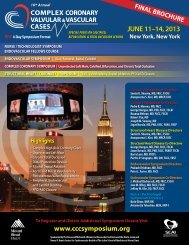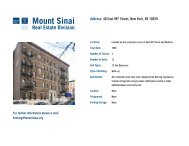CARDIAC CATH LAB - Mount Sinai Hospital
CARDIAC CATH LAB - Mount Sinai Hospital
CARDIAC CATH LAB - Mount Sinai Hospital
You also want an ePaper? Increase the reach of your titles
YUMPU automatically turns print PDFs into web optimized ePapers that Google loves.
Michael C. Kim, MD<br />
Director, Coronary Care<br />
Unit, on Door-2-Balloon<br />
Time in STEMI<br />
This past year MSH<br />
achieved an almost<br />
unprecedented D2B<br />
record of less than 90<br />
minutes in over 95% of<br />
our STEMI patients.<br />
The most serious heart attack is signaled<br />
by characteristic ST elevations on the<br />
surface electrocardiogram; hence the<br />
name ST segment elevation myocardial<br />
infarction, or STEMI. Rapid intervention<br />
in STEMI is critical because the condition,<br />
which is triggered by a total blockage of a<br />
coronary artery, can result in a significant<br />
portion of the heart muscle dying due<br />
to lack of blood supply if not cleared quickly. It’s the cardiac condition<br />
people fear most when they say “heart attack” and with good reason;<br />
50 percent of patients never even make it to the hospital alive.<br />
Because patient mortality rates have remained high in this medical<br />
emergency even as others improve, and because angioplasties are the<br />
ideal method of treatment, the American College of Cardiology (ACC)<br />
declared a national “Door to Balloon” (D2B) initiative in 2006, calling<br />
on every hospital to examine performance with the goal of treating<br />
STEMIs (by balloon catheterization, for example) within 90 minutes<br />
of a patient’s arrival at the ER “door.” <strong>Mount</strong> <strong>Sinai</strong>, which already<br />
had an outstanding record of performance in treating STEMIs, took<br />
up the challenge. This past year we achieved an almost unprecedented<br />
D2B record of less than 90 minutes in over 95 percent of our STEMI<br />
patients, with a caseload of 150 to 200 patients annually. In one<br />
notable instance our D2B interval was only 20 minutes! Offering these<br />
kinds of responses when only 30 percent of hospitals nationwide are<br />
consistently doing so is significant.<br />
How do we do this? The simple answer is that we have examined every<br />
detail of our program and developed better strategies for getting these<br />
critically ill patients to the cath lab without any unnecessary delay. As<br />
we are known to the city’s ambulance services as offering outstanding<br />
care and rapid response, a patient suspected of a STEMI is likely to be<br />
brought here even if it means bypassing a closer hospital without a<br />
24 <strong>Mount</strong> <strong>Sinai</strong> <strong>Hospital</strong> Cardiac Cath Lab



![December 2, 2012 [PDF] - Mount Sinai Hospital](https://img.yumpu.com/51092274/1/190x245/december-2-2012-pdf-mount-sinai-hospital.jpg?quality=85)
![January 21, 2013 [PDF] - Mount Sinai Hospital](https://img.yumpu.com/50916550/1/190x245/january-21-2013-pdf-mount-sinai-hospital.jpg?quality=85)

![February 3, 2013 [PDF] - Mount Sinai Hospital](https://img.yumpu.com/50584982/1/190x245/february-3-2013-pdf-mount-sinai-hospital.jpg?quality=85)
![March 18, 2012 [PDF] - Mount Sinai Hospital](https://img.yumpu.com/50462098/1/190x245/march-18-2012-pdf-mount-sinai-hospital.jpg?quality=85)
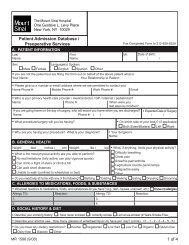
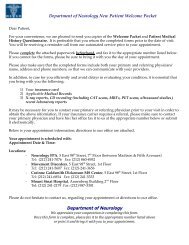

![Partners Program Guide [PDF] - Mount Sinai Hospital](https://img.yumpu.com/49411954/1/190x245/partners-program-guide-pdf-mount-sinai-hospital.jpg?quality=85)
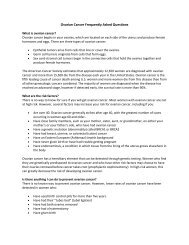
![March 19 - April 1, 2012 [PDF] - Mount Sinai Hospital](https://img.yumpu.com/48990923/1/190x245/march-19-april-1-2012-pdf-mount-sinai-hospital.jpg?quality=85)
![PGY-1 Residency Application [PDF] - Mount Sinai Hospital](https://img.yumpu.com/48577701/1/190x245/pgy-1-residency-application-pdf-mount-sinai-hospital.jpg?quality=85)
